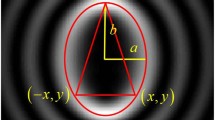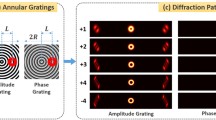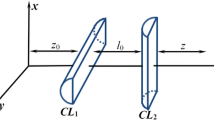Abstract
We theoretically and experimentally investigate the Fraunhofer diffraction pattern of a vortex beam passing through an annular ellipse aperture. It is found that the pattern of the far-field diffraction intensity distribution exhibits some dark spots, which become clearer with increasing the value of the ellipticity factor of the annular ellipse aperture. The diffraction phenomenon is more obvious with increasing the value of the ratio of the inner long axis (or short axis) to the outer side of the annular ellipse aperture. The number of the dark spots in the Fraunhofer diffraction intensity distribution is just equal to the topological charge value of the measured optical vortex, and the centre of each dark spot is just a phase-singularity point. Based on this property, we can measure the topological charge of an optical vortex beam.
Similar content being viewed by others
Avoid common mistakes on your manuscript.
1 Introduction
The vortex beam, also known as the helical beam, is a singular beam which has a continuous spiral phase wave front and a central dark point in the intensity profile, and whose phase factor is exp(ilθ). Each photon of such a beam carries an orbital angular momentum (OAM) of lħ, where l is the topological charge [1]. In recent years, a great deal of attention has been given to the research of the vortex beam owing to it having special applications in many areas, such as the trapping and rotating of micro-particles [2, 3], quantum communication [4], astronomy [5] etc. The topological charge of a vortex beam also can be used in optical information encoding, which has advantages of high capacity, high security etc. [6, 7]. Therefore, measuring the topological charge of a vortex beam becomes a task of great significance.
Several approaches for measuring the topological charge of an unknown vortex beam have been developed, such as the Mach–Zehnder interferometer with a Dove prism placed in each arm [8], the double-slit interference [9] and the multiple-pinhole interferometer [10], which are based on the interference principle. Recently, Hickmann et al. [11] observed the generation of a truncated triangular optical lattice when a vortex beam passed through an equilateral triangular aperture. Moreno and Davis [12] introduced a technique to characterize the topological charge of an optical vortex through its diffraction intensity pattern after a fork-shaped grating. Guo et al. [13] found that the far-field diffraction intensity pattern of an optical vortex passing through a circular annular aperture comprises some bright and dark rings, and the number of the bright rings is just equal to the topological charge value of the measured optical vortex. Also, Liu et al. [14] obtained the magnitude and sign of the topological charge of the incident vortex beam just by counting the external spot points of the triangular lattice array and observing the shape of the diffraction pattern when the measured optical vortex passed through an annular triangle aperture. Although the two types of annular apertures described above have been used to measure the topological charge of an optical vortex beam, to our knowledge there is no report about the optical vortex passing through an annular ellipse aperture.
In this paper we will study the diffraction of a vortex beam passing through an annular ellipse aperture theoretically and experimentally. It is found that the diffraction pattern is associated with the topological charge of the incident vortex beam, the ellipticity factor and the ratio of the inner to the outer side of the annular ellipse aperture. We also notice that the number of the dark spots in the far-field diffraction intensity distribution is just equal to the topological charge of the measured optical vortex, and that the centre of each dark spot is a phase-singularity point. From these phenomena, we present a simple and feasible way for measuring the topological charge of a vortex beam.
2 Theory formulation
We consider a vortex beam as the incident beam; the electric field distribution at the annular ellipse aperture plane (i.e. z=0 plane) can be expressed as [15]

where w 0 is the waist width of the vortex beam and l is the topological charge.
It is assumed that the vortex beam is diffracted by an annular ellipse aperture whose transmittance is τ(x 0,y 0). The field distribution in an observation plane can be obtained by the Fraunhofer diffraction integral

By numerically solving the integral shown in (2), we can obtain the diffraction pattern of a vortex beam through an annular ellipse aperture. The Fraunhofer diffraction patterns and the corresponding phase distributions for vortex beams with different values of the topological charge l diffracted by an annular ellipse aperture are shown in Fig. 1. The ellipticity factor and the ratio of the inner long axis (or short axis) to the outer side of the annular ellipse aperture are chosen as e=0.8 and η=0.8. It is found from Fig. 1a–c that the Fraunhofer diffraction patterns become larger with increasing the value of the topological charge l, and the number of the dark spots of the diffraction patterns not only increases with l, but also is just equal to the topological charge l. Comparing Fig. 1a–c with Fig. 1d–f, it is easy to find that the centre of each dark spot is a phase singularity. We find that, when the vortex beam with topological charge l is passing through the annular ellipse aperture, the singularity with a topological charge l of the incident vortex beam splits into l singularities, each with unitary topological charge.
Changing the ellipticity factor of the annular ellipse aperture and numerically solving (2), we get Fig. 2. It shows the far-field diffraction patterns for vortex beams with different values of the topological charge l diffracted by the annular ellipse aperture with different ellipticity factors, in which (a), (b), (c) e=0.6 and (d), (e), (f) e=0.7 and the ratio of the inner long axis (or short axis) to the outer side η=0.8. We find from Fig. 2 that the Fraunhofer diffraction patterns also become larger with increasing the value of the topological charge l. In addition, comparing Fig. 2a–c or Fig. 2d–f with Fig. 1a–c, it is easy to find that the diffraction patterns become narrower and the dark spots become clearer with increasing the value of the ellipticity factor e.
In Fig. 3, we present the far-field diffraction patterns for the vortex beams with different values of the ratio of the inner long axis (or short axis) to the outer side diffracted by the annular ellipse aperture, in which (a), (b), (c) η=0 and (b), (e), (f) η=0.6 and the ellipticity factor e=0.8. It is found that the diffraction phenomenon is more obvious with increasing the value of the ratio of the inner long axis (or short axis) to the outer side η (the inner side is close to the outer side of the annular ellipse aperture).
3 Experimental results and analysis
To demonstrate the method described above, we carried out some experimental research. As shown in Fig. 4, a vortex beam possessing OAM is generated by passing a nearly Gaussian beam onto a spiral phase plate (SPP) with specific topological charge. An annular ellipse aperture is placed behind the SPP to diffract the vortex beam. Then we record the far-field diffraction pattern at the lens’s focal plane using a CCD.
The experimental results for the diffraction of vortex beams are shown in Fig. 5, from which we can straightforwardly obtain the topological charge value of the incident vortex beam just by counting the number of the dark spots. Comparing Fig. 5a–c with Fig. 1a–c and Fig. 5d–f with Fig. 2a–c, we find that the experimental results are consistent with the theoretical ones. We notice that there is a kind of symmetry breaking in the observed diffraction patterns. This phenomenon may be due to the fact that the vortices of the beams are not aligned with either of the ellipse axes. Figure 5g–i show the Fraunhofer diffraction patterns recorded in our experiments with the topological charge l=3 of the incident beam for different values of η, respectively. We find that the diffraction phenomenon is more obvious with increasing the value of η. The result is accord with the theoretical result from Fig. 3.
4 Conclusions
We have theoretically and experimentally demonstrated the far-field diffraction intensity pattern of an optical vortex beam diffracted by an annular ellipse aperture. It is found that the dark spots in the diffraction field become clearer with increasing the value of the ellipticity factor of the annular ellipse aperture. We also find that the diffraction phenomenon is more obvious with increasing the value of η. Based on the diffraction pattern of the vortex beam, we can easily measure the topological charge of the incident vortex beam.
References
L. Allen, M.W. Beijersbergen, R.J.C. Spreeuw, J.P. Woerdman, Phys. Rev. A 45, 8185 (1992)
H. He, M.E.J. Friese, N.R. Heckenberg, H. Rubinszstein-Dunlop, Phys. Rev. Lett. 75, 826 (1995)
V. Garces-Chavez, D. McGloin, M.J. Padgett, W. Dultz, H. Schmitzer, K. Dholakia, Phys. Rev. Lett. 91, 093602 (2003)
G. Molina-Terriza, J.P. Torres, L. Torner, Nat. Phys. 3, 305 (2007)
G. Foo, D.M. Palacios, G.A. Swartzlander Jr., Opt. Lett. 30, 3308 (2005)
Y. Liu, C. Gao, M. Gao, F. Li, Acta Phys. Sin. 56, 854 (2007)
G. Gibson, J. Courtial, M.J. Padgett, Opt. Express 12, 5448 (2004)
J. Leach, J. Courtial, K. Skeldon, Phys. Rev. Lett. 92, 013601 (2004)
H.I. Sztul, R.R. Alfano, Opt. Lett. 31, 999 (2006)
G.C.G. Berkhout, M.W. Beijersbergen, Phys. Rev. Lett. 101, 100801 (2008)
J.M. Hickmann, E.J.S. Fonseca, W.C. Soares, S. Chavez-Cerda, Phys. Rev. Lett. 105, 053904 (2010)
I. Moreno, J.A. Davis, Opt. Lett. 34, 2927 (2009)
C. Guo, L. Lu, H. Wang, Opt. Lett. 34, 3686 (2009)
Y. Liu, H. Tao, J. Pu, B. Lü, Opt. Laser Technol. 43, 1233 (2011)
D.M. Palacios, I.D. Maleev, A.S. Marathay, G.A. Swartzlander Jr., Phys. Rev. Lett. 92, 143905 (2004)
Acknowledgements
This research was supported by the National Natural Science Foundation of China under Grant Nos. 60977068 and 61178015.
Author information
Authors and Affiliations
Corresponding author
Rights and permissions
About this article
Cite this article
Tao, H., Liu, Y., Chen, Z. et al. Measuring the topological charge of vortex beams by using an annular ellipse aperture. Appl. Phys. B 106, 927–932 (2012). https://doi.org/10.1007/s00340-012-4911-2
Received:
Revised:
Published:
Issue Date:
DOI: https://doi.org/10.1007/s00340-012-4911-2









